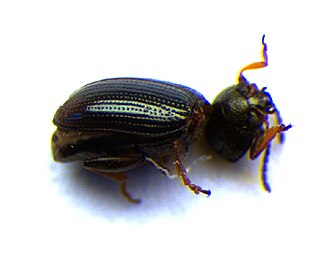
Cassida is a large Old World genus of tortoise beetles in the subfamily Cassidinae. Several species of Cassida are important agricultural pests, in particular C. vittata and C. nebulosa on sugar beet and spinach. The thistle tortoise beetle has been used as a biological control agent against Canada thistle.
Chaetocnema rileyi, the Boca Chica flea beetle, is a species of flea beetle in the family Chrysomelidae. It is found in North America.

Kuschelina is a genus of flea beetles in the family Chrysomelidae. There are at least 20 described species in Kuschelina.

Mantura is a genus of flea beetles in the family Chrysomelidae. There are about 11 described species in Mantura.

Rhabdopterus is a genus of leaf beetles in the subfamily Eumolpinae. There are about 70 described species in Rhabdopterus from North and South America, eight of which are found north of Mexico. The Nearctic species may not be congeneric with the type species, which is South American.
Rhabdopterus deceptor is a species of leaf beetle. It is found in North America.
Acanthoscelides tridenticulatus is a species of leaf beetle in the family Chrysomelidae. It is found in North America.
Cryptocephalus nanus is a species of case-bearing leaf beetle in the family Chrysomelidae. It is found in North America.
Fidia texana is a species of leaf beetle that is found in North America. It occurs in central and east-central Texas, and is associated with plants in the grape family (Vitaceae). Fidia texana was first described as a variety of Fidia viticida by the American entomologist Charles Frederic August Schaeffer in 1933. It is now considered to be a separate species.
Algarobius prosopis is a species of leaf beetle in the family Chrysomelidae. It is found in Africa, Europe & Northern Asia, Central America, and North America.
Acanthoscelides chiricahuae is a species of leaf beetle in the family Chrysomelidae. It is found in Central America and North America.
Sennius leucostauros is a species of leaf beetle in the family Chrysomelidae. It is found in Central America and North America.
Cryptocephalus castaneus is a species of case-bearing leaf beetle in the family Chrysomelidae. It is found in North America.
Phaedon desotonis, known generally as the desoto leaf beetle or coreopsis leaf beetle, is a species of leaf beetle in the family Chrysomelidae. It is found in North America.
Rhabdopterus weisei is a species of leaf beetle. It is found in North America. It was originally described under the name Colaspis subaenea by the American entomologist Charles Frederic August Schaeffer in 1919. However, this name was already used for a species described by Martin Jacoby in 1890, so Schaeffer renamed his species to Colaspis weisei the following year. It was later moved to the genus Rhabdopterus by Herbert Spencer Barber in 1943.

Charidotella is a genus of tortoise beetles in the family Chrysomelidae. There are at least 100 described species in Charidotella.
Hemiglyptus is a genus of flea beetles in the family Chrysomelidae. There is at least one described species in Hemiglyptus, H. basalis.

Demotina modesta is a species of leaf beetle. It is an adventive species in the southeastern United States in North America, while its native range includes Japan and Korea. It is very abundant on oaks. It is known to be parthenogenetic in part of its native range, and no males are known from North America.
Cadiz is a genus of leaf beetles in the subfamily Chrysomelinae, found in North America. It contains only one species, Cadiz hardyi, which was described from the Cadiz Dunes in San Bernardino County, California.
Acrocyum is a genus of flea beetles in the family Chrysomelidae. There is at least one described species in Acrocyum.





